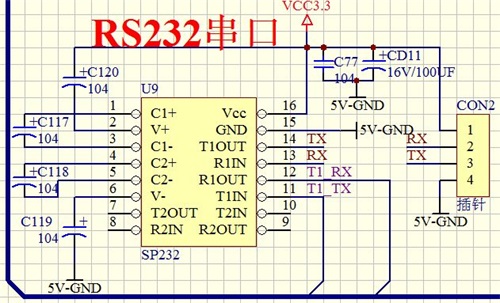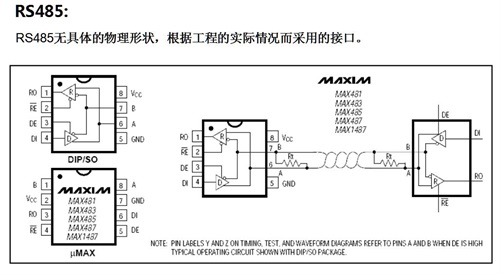RS232 and RS485 have always been common weak current interfaces, but many people do not fully understand the differences between them. Today, this article will explain to you the characteristics and differences of RS232 and RS485.


1. Overview of RS232
The RS-232 interface complies with the interface standard for serial data communication established by the Electronic Industries Alliance (EIA). The full name of the original number is EIA-RS-232 (referred to as 232, RS232). It is widely used for computer serial interface peripheral connections. Connecting cables and machinery, electrical characteristics, signal functions and transmission processes.


The data transmission rates specified by the RS-232-C standard are 50, 75, 100, 150, 300, 600, 1200, 2400, 4800, 9600, and 19200 baud per second.
2. RS232 features
RS-232 is one of the current mainstream serial communication interfaces. Since the RS232 interface standard appeared earlier, it inevitably has shortcomings, mainly including the following four points:
(1) The signal level of the interface is relatively high, which can easily damage the chip of the interface circuit. The voltage of any signal line of the RS232 interface has a negative logic relationship. That is: logic “1” is -3–15V; logic “0”: 3-15V, and the noise margin is 2V. That is, the receiver is required to recognize signals higher than 3V as logic “0”, signals lower than -3V as logic “1”, TTL level of 5V is logic positive, and 0 is logic negative. It is not compatible with TTL levels, so a level conversion circuit is required to connect to TTL circuits.
(2) The transmission rate is low. During asynchronous transmission, the bit rate is 20Kbps; therefore, in the 51CPLD development board, the integrated program baud rate can only be 19200 for this reason.
(3) The interface uses a signal line and a signal return line to form a common-ground transmission form. This kind of common-ground transmission is prone to common-mode interference, so its immunity to noise interference is weak.
(4) The transmission distance is limited. The standard maximum transmission distance is 50 feet, but in fact it can only be used at about 15 meters.
3. Overview of RS485
When the communication distance is required to be from tens of meters to thousands of meters, the RS-485 serial bus is widely used. RS-485 uses balanced transmission and differential reception, so it has the ability to suppress common mode interference. In addition, the bus transceiver has high sensitivity and can detect voltages as low as 200mV, so the transmitted signal can be recovered thousands of meters away.


RS-485 uses half-duplex working mode, and only one point can be in the sending state at any time. Therefore, the sending circuit must be controlled by the enable signal.
4. RS485 features
RS-485 is very convenient for multi-point interconnection and can save many signal lines. RS-485 can be used to network to form a distributed system, which allows up to 32 drivers and 32 receivers to be connected in parallel. In response to the shortcomings of RS-232-C, the new standard RS-485 has the following characteristics:
(1) Electrical characteristics of RS-485: Logic “1” is represented by the voltage difference between the two lines of 2V~6V, and logic “0” is represented by the voltage difference between the two lines -6V~-2V. The interface signal level is lower than RS-232-C, so it is not easy to damage the interface circuit chip, and the level is compatible with the TTL level, making it easy to connect to the TTL circuit.
(2)The maximum data transmission rate is: 10Mbps
(3) The RS-485 interface uses a combination of balanced drivers and differential receivers, which has strong anti-common mode interference capabilities, that is, good anti-noise performance.
(4) The maximum transmission distance of the RS-485 interface is standard 4000 feet, but can actually reach 3000 meters.
(5) The RS-232-C interface only allows one transceiver to be connected to the bus, that is, single-station capability; while the RS-485 interface only allows up to 128 transceivers to be connected to the bus, that is, it has multi-station capability, so users Device networks can be easily established using a single RS-485 interface.
5. Application areas
RS-232 is now generally used in short-distance transmission with low data transmission rates. It can also work effectively in noisy environments, such as factories, public sites, etc. Its commonly used equipment includes low-speed modems, industrial control equipment, and programmable logic controllers ( PLC), computer numerical control (CNC) machine tools, robots, embedded control computers, medical instruments and equipment, and embedded controller development systems.
RS-485 is often used in long-distance transmission with high data transmission rates. Commonly used equipment includes point-of-sale terminals (POS), measuring instruments, and large-scale special automation machines.
But in ordinary applications, we often need to convert between two different interface types. At this time we can use the now popular USB interface, which can help us convert to RS-232 interface and RS-485 interface.
To sum up, RS-232 is suitable for short-distance low-speed transmission requirements, while RS-485 is suitable for long-distance transmission. RS-485 is a new interface standard that emerged to address the shortcomings of the RS-232 interface. It has become the preferred standard because of its good anti-noise interference capabilities and multi-station capabilities.